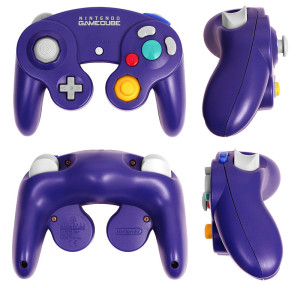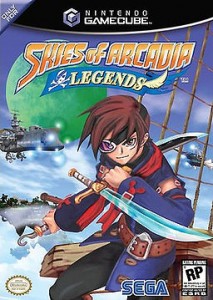This week I would like to take a quick look back at that third wheel of the sixth console generation: the Nintendo GameCube. As Nintendo’s last traditional home console, the GameCube stands in contrast to its successors the Wii and Wii U. Not relying on any particular gimmick to draw in attention or to set it apart, the GameCube nevertheless still had some distinguishing features that shaped its performance throughout its lifespan. Perhaps the most prominent of them was the proprietary mini discs that also required a special laser to read the data stored on them. More noticeable was the GameCube’s controller that featured a layout both reminiscent and new. The general layout of the face buttons, shoulder triggers, and analogue sticks were all quite similar to contemporary designs, but the size and exact positioning eschewed the more traditional diamond layout made popular by the Super Nintendo. The system would also go on to produce the first worthwhile wireless controller, the Wavebird, which untethered gamers from their systems by offering an incredible functional range of operation at the expense of the rumble feature. In terms of hardware, the GameCube stood toe to toe with the Microsoft’s original Xbox and towered over the otherwise dominant PlayStation 2. Indeed, this system came out of a Nintendo that held relatively true to console design fundamentals as opposed to the, to put it unflatteringly, gimmick oriented Nintendo that would produce the DS series of consoles and pioneer the rise of motion controls. And the reasons for this shift in design were thanks in no small part to the change in leadership, from Yamauchi to Iwata in 2002, as well as the general lacking performance of the GameCube in an environment where it struggled to differentiate itself from its competitors in any meaningful way.
To write at length about any console would also be to mention some of its more prominent software as well. I had mentioned a few times in the past that Capcom’s Resident Evil series being fully ported over to the system was one of the bigger software accomplishments of the GameCube. Perhaps that speaks to the general level of accomplishment the system achieved, however those games did prove to make the GameCube the single best machine on which to experience the entire Resident Evil series. The deal for that series would also come around the same time Nintendo was working with then-second-party Silicon Knights as they produced the decidedly mature Eternal Darkness: Sanity’s Requiem. The release of these games in close proximity would go a small way in shaking up Nintendo’s kid friendly image, though of course it would not sway overall public opinion on the matter. In all likelihood, these were decisions being brought about by a Nintendo that was still questioning some of its practices and examining its position in the industry. The same Nintendo that allowed Majora’s Mask to hit store shelves. Very much not the Nintendo of today, which still rolls in the money it made hand over fist during the height of the Wii’s popularity. Though as the GameCube matured and the change in management took hold, as well as with the launch of the DS and the appointment of Reggie Fils-Aime as NOA president, Nintendo would once again take a step back into the more kid friendly realm, leaving some of the darker exploits of the Nintendo 64 and early GameCube days behind.
Sadly, the GameCube can sometimes be notable for what it did not have, as much as for what it actually offered. The greatest lacking aspect of the console, the singular thing that made me finally stop being a Nintendo-only console owner and purchase a PlayStation 2, was the system’s critical lack of RPGs. Though some noteworthy examples do exist on the system, it was nothing compared to the veritable deluge of RPG content waiting to be played on Sony’s competing console. Back in the days of game rentals, I would always notice enticing RPGs sitting, practically lining, the PlayStation section of the shelves. Not only was the GameCube section much smaller overall, but its games were updated far less. Eventually, despite being a fairly devout fanboy at the time, I broke out of my loyalty and became a two console gamer for the first time. I believe some of my first purchases for the PlayStation 2 included Xenosaga and Final Fantasy X. And yet, for those who might know me well, my favorite RPG does reside on the GameCube. Yes I am giving mention once again to Sega’s Skies of Arcadia Legends. Without getting into the details for why I love it so, I will simply say that this game went a long way in holding me over before I finally felt I needed more out of my RPG experience. A sprinkling of other RPGs did grace the console, such as the first console Fire Emblem title, and a few other offerings I had little interest in. But overall, the GameCube was not a good friend to the avid RPG fan.
Finally, I would like to give a mention to one game that still marks the highlight of my GameCube experience. A game made great from equal parts genius on the part of the developer and dedication on the part of the community. Super Smash Bros. Melee, a launch window release title, still stands in my mind as the single best game for the system. It was the greatest reason to get the system at launch and would remain the only reason I would tote the system around to friend’s houses or leave it plugged in at home well after the release of the Wii. The game, a unique mascot fighting game first introduced on the Nintendo 64, is the epitome of the Nintendo design ideal of “easy to pick up, difficult to master”. Unlike other popular fighting games, Melee does not ask the player to memorize unique button inputs for each character as they all share the same move sets. The ring-out style of victory also places great emphasis on the stage being played on, introducing some light platforming elements to the game. However, skill unquestionably separates the good players from the bad, even with the game’s more random elements turned on, like items. A great many techniques were designed into the game that required precise timing and foreknowledge of how they work and when to use them. L-Canceling, Directional Influence, sweetspotting, aerial buffering, these all sound like glitchy exploits dredged up by hardcore players, but they are actually all designed into the game. Which is not to say some exploits were not found, several of which would go a long way in changing the fundamentals of high level tournament play. And that, perhaps, is the GameCube’s legacy. A singular title, still being played to this day at professional tournaments, most recently EVO 2013, that is equally capable of being both a casual party game and among the fastest fighting games ever made. It is a balance in game design that any game making company would do well to strive for.
And so my look back at the purple lunch box is over. I have a sneaking suspicion that most of you readers were GameCube owners, and chances are that you loved the system too. Despite its shortcomings, the system still endears me to it. It is still plugged in at my house! So, what memories, if any, do you guys have? What great games did I miss (I know I missed several) that made the GameCube special? And do not be afraid to speak ill of the system, for there is much ill to speak of. The important thing is that you make your comment!

